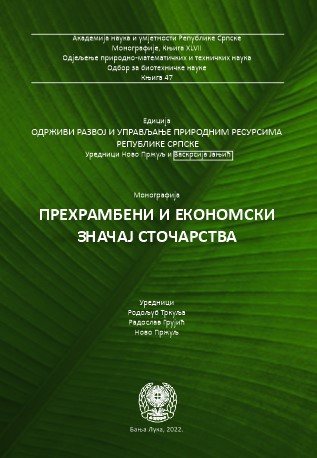Sheep and goat breeding
DOI:
https://doi.org/10.7251/EORU2204065ZKeywords:
Sheep, goat, extensiveness, selection, breeding goals, reproduction, productsAbstract
The beginnings of sheep and goat production go back to the dawn of human civilization. In the geographical areas where the first human civilizations began to develop, the domestication of sheep from wild animals that lived there began. The first domesticated animals did not differ much from their original forms and changes in morphological and production characteristics followed later during the development of sheep and goat production. Significant contributions to the development of these branches of animal husbandry were made by ancient world cultures such as Egyptian, Greek, and Roman. Changes in production were formed specifically to meet the needs of specific products such as wool, meat and milk. In this process, significant morphological modifications have occurred, such as changes in hair in wool in sheep, changes in the skin, deposition of adipose tissue, horn lessness and so on. In addition to this, there was a differentiation of breeds in accordance with the production goals that were primary, so that meat, dairy and wool production types were singled out. Along with the processes of differentiation of production types, a large number of breeds have developed, mainly according to geographical distribution. New breeds have characteristics that have been developed under the influence of man and are based on specialized or combined production of milk, meat and wool. In Europe, sheep production accounts for a significant share of total livestock production, especially in countries where cattle production has been reduced due to various geographical factors. In sheep and goat production in Europe, the leading countries are the Mediterranean countries, which have developed traditional sheep and goat products of high economic value. In Bosnia and Herzegovina, sheep and goat production are not at a satisfactory level. It is mostly about extensive sheep and goat farming without organized and systemic solutions to the problems in this production. The breed composition in Bosnia and Herzegovina is based mostly on strains of the autochthonous pramenka breed without organized selection work. Typically, sheep and goat products should be based on different technological processes such as the production of meat, milk, wool and combined output. The breeding system itself is based on the breeding of purebred breeding heads and the breeding of commercial heads for production and the market. An important element of breeding is reproduction, since these are seasonal animals whose mating season is in the fall. In order to increase the productivity and accumulativeness of these branches of livestock production, the method of estrus synchronization using various hormonal preparations is applied. Defining breeding goals is the main starting point when it comes to any livestock production, so this is the case with sheep and goat breeding. Animal selection is carried out in accordance with breeding goals. In addition to economic importance, sheep and goat production play an important role as an ecological factor in the use, preservation and conservation of pastures.
